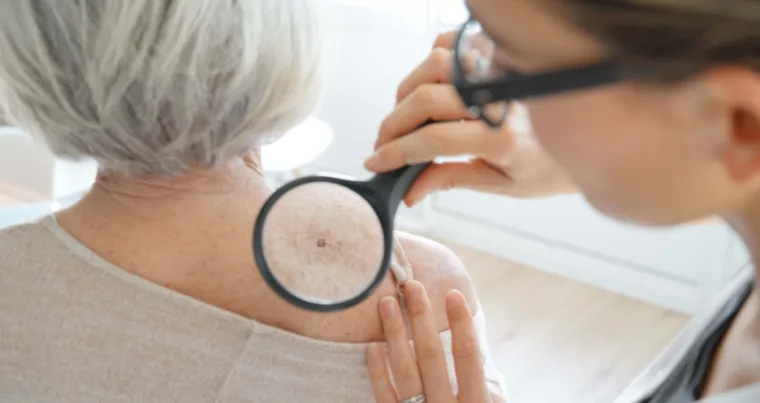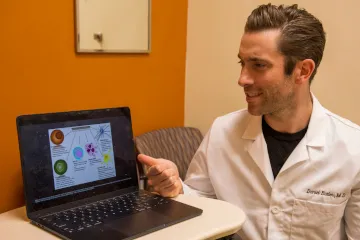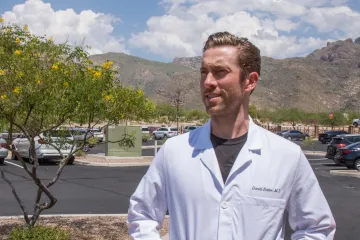Bringing a new dermatology discipline to Tucson

The College of Medicine – Tucson is launching a research program devoted to aging skin, bringing the emerging field of geriatric dermatology to Southern Arizona.
Tucson native Daniel Butler, MD, is a double Wildcat with an undergraduate degree in psychology from the University of Arizona and a medical degree from the College of Medicine – Tucson. Last year, nearly a decade after graduating with the Class of 2014, he returned to Tucson with his family.
“We always wanted to come back,” he said. “The opportunity to start a research program was certainly one factor behind our decision. The opportunity to have a leadership role in education was another one. Also, my parents live here and we just had a baby.”
In addition to his clinical practice at Banner – University Medicine, Dr. Butler serves as the assistant dean of student affairs and is busy launching the Division of Dermatology’s Inflammatory and Aging Skin Research Program, which will expand treatment options for inflammatory skin diseases through clinical care and clinical trials, and support scientific research in aging skin.
The ethos driving Dr. Butler’s program is improving care for skin disease in older patients — not finding ways to fight the signs of aging. He believes that “normalizing” aging honors patients’ experiences and dermatologists’ roles as partners in their care — and helps us better understand healthy aging.
“Nobody wants to age, but the fact of the matter is that everybody is aging,” he said. “As dermatologists and doctors, we have to be realistic about what that is supposed to look like.”
Caring for — and about — aging skin
Dr. Butler says many of the “classic” dermatological diseases are inflammatory. Inflammation is a normal part of the immune response, but when it’s too strong or lasts too long, it can damage healthy tissues. Although skin complaints are common among older adults, many of these conditions have limited treatment options — which could be related to research gaps in the relationship between skin and aging.

“The skin has never really been seen as a marker for understanding aging. It’s mostly been a target for anti-aging research,” Dr. Butler said. “Understanding what’s going on in the skin and how that relates to aging is this scientific mystery.”
Dr. Butler gives the example of itching, which he says is the most common reason people over the age of 50 see a dermatologist.
“Because it’s an aging thing, we didn’t really look at it, scientifically — despite that fact that almost everyone in the population has it, and the rates are alarming in people over 65,” he said. “Finally, in the last five years, we’re starting to look at a disease that literally billions of people have, that particularly affects older adults. We’re developing targeted medications — not just an over-the-counter cream, not just a Benadryl at night.”
Improved medications aren’t the only benefit of research into aging skin. Understanding why itching is more common in older adults could lead to broader discoveries about aging and immunity in general.
Dr. Butler describes the aging immune system as “splayed out.” A well-functioning immune response hits a target to stop a threat, like a hose focusing water into a jet. As the immune system ages, the “hose” starts to spray outward, hitting unwanted targets and setting off other problems. There could be connections between a purely dermatological issue like itching and inflammatory diseases in other areas of the body.
“Medication that impacts the immune system of the skin can also have a positive impact on other organ systems,” he said. “It’s like the skin is an outward reflection of aging, and it holds a lot of secrets of entire processes that are going on in our body. There are a lot of complex systems at play.”
Bringing a new discipline to Tucson
As a medical student, Dr. Butler was on the path to be a geriatrician, but he noticed that older people — even those with life-or-death conditions like cancer — chiefly complained about skin conditions.
“They had all these major diseases, and their skin disease was impairing their quality of life. I got interested in that,” he recalled. “Through various odd paths, I ended up finding researchers who had published articles in aging skin and geriatric disease.”
After completing his residency at Harvard, he went to the University of California, San Francisco. There, he was on the ground floor of an emerging specialty.
“We had the country’s first geriatric dermatology clinic at UCSF, looking at the diseases that pop up with aging skin,” he said. “A lot of flagship diseases in dermatology affect older adults in unique ways — things like atopic dermatitis, psoriasis and pruritus, which is our fancy word for itching. I was interested in how aging was a unique factor for those.”
Researchers with the UCSF Aging Skin Collaborative wondered if the skin could be a “window” into the aging process. As a member of this one-of-a-kind group, Dr. Butler worked to unravel the mysteries of the aging skin.
“I wanted to bring that momentum here,” Dr. Butler says of the Inflammatory and Aging Skin Research Program, which he hopes will attract talent from across the world in addition to leveraging the homegrown expertise of researchers across the College of Medicine – Tucson and UArizona Health Sciences, such as those at the Center on Aging, Department of Immunobiology and Skin Cancer Institute.
Improving patient care and medical education
Dr. Butler is eager to put his team’s expertise into practice. He wants local patients and dermatologists to know that the Banner – University Medicine Multispecialty Services Clinic at Pima Canyon can see patients with tricky cases.

“We feel really comfortable with the most complex patients,” Dr. Butler said. “We want patients to see us as a place of innovation, investigation and creativity. That’s what academic centers provide around the country. They’re able to offer you everything and a little bit more.”
That “little bit more” includes access to cutting-edge treatments through clinical trials — and making them open to participants of all ages and with a variety of conditions. Clinical trials assess new treatments for safety and efficacy, and participants may be among the first to benefit from next-generation drugs. Tucson doesn’t have a lot of clinical trials for skin conditions — but Dr. Butler is working to change that.
“We’re creating Tucson’s only skin clinical trials unit. We have a lot of skin diseases in Tucson, and they have a ton of new medications coming out,” Dr. Butler said. “In addition to itch, conditions such as hidradenitis suppuritiva, psoriasis, vitiligo and others have long been overlooked in drug development. Now that we’re starting to see advances in treatment, we hope to bring this progress to Tucson. The community deserves access to cutting-edge treatments — particularly when few or no other treatments exist.”
Local patients aren’t the only people who will benefit from these new programs. Medical students and residents will also enjoy enriched educational opportunities — exposure to clinical trials, clinical research and translational science — at one of the only places in the country where geriatrics and dermatology dovetail.
“We can offer the next group of students or residents a healthy learning environment for curiosity and growth — a nice springboard to create new ideas they may carry for the rest of their career,” Dr. Butler said. “It did for me when I got exposure to clinical research when I was a student. That was really instrumental for me.”
The skin is the largest organ in the body and older people are one of the fastest-growing populations in the country. Dr. Butler thinks both need more attention and is excited to build a program that will expand the field of dermatology in multiple directions — scientifically, clinically, pedagogically.
“Our goal is to build a world-class, state-of-the-art clinical research program that has multiple investigative and translational arms, and is a world leader at aging skin disease,” he said. “The aging skin space is ripe for the picking. No one else is doing it.”
Anyone interested in participating in dermatology clinical trials, including those that will be conducted through the Inflammatory and Aging Skin Research Program, can learn more on the College of Medicine – Tucson Clinical Research Studies website.

